EPSC Sedimentology Field Trip 2018: Sedimentary Basins and Sequence Stratigraphy
This year EPSC has run a sedimentary geology field trip to Spain. Ten undergraduate students enrolled in EPSC 425 (Sediments to Sequences), 8 graduate students in a Sedimentary Basins graduate seminar, and professor Al Mucci joined me for this edition, which was somewhat longer than previous trips (9 days in the field) and covered more ground. This year, we successfully visited the Maestrat basin near Aliaga in the Iberian Ranges fold-and-thrust belt, then continued north across the Ebro foreland basin and into the foothills of the Pyrenees. We finished the trip at the world-class K-Pg and PETM deepwater (flysch) sections at Zumaia, between Bilbao and San Sebastian. The trip was extraordinary and highly educational for al, and it would not have been possible without the generous support of McGill donors and funding from Shell Canada.
Note that you can download higher-resolution versions of all the photos below by double-clicking on the photo.
Day 1. On March 2 the group met at the Madrid Airport, with only one casualty (non-arrival) from inclement weather in Ireland and the UK. Having rented our three vans, we set off for the town of Guadix, on the north flank of the Sierra Nevada and a 45-minute drive from Granada. Heavy doses of caffeine and the buzz of being back in Spain propelled us as we pushed through rain storms and jet lag to our destination: the Hotel Mulhacén. Following a brief rest, we made our way to the Bodega Calatravas, one of my favourite tapas places in the world. The Spain 2018 was officially underway!
Day 2. As per tradition, Fernando García-García of the University of Granada met us in Guadix and led us through the instructive outcrops of the Guadix Basin. Despite significant recent rain (the first in five years), perilously low water levels in the Francisco Abellán Reservoir permitted us to see lower in the stratigraphy of the Tortonian marine deposits than we had previously witnessed. As always, it was a great day in and around Guadix, and we enjoyed visiting both the usual outcrops and new ones, including massive travertine deposits and the Acequia Toril near Villaneuva de las Torres (I always enjoy visiting this area, too, because there is a nearby town called 'Pedro Martinez,' the name of a legendary former Expos and Red Sox pitcher).
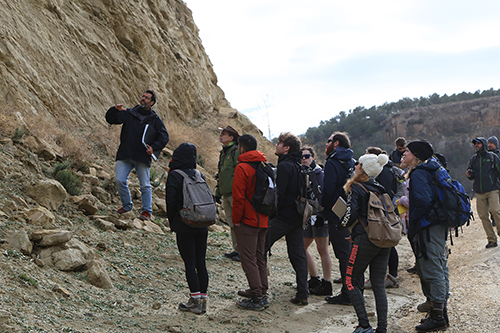 Fernando makes his case that these sediments were deposited on a delta slope, rather than in deepwaters as previous sedimentologists had hypothesized. He convinced most of us!
Fernando makes his case that these sediments were deposited on a delta slope, rather than in deepwaters as previous sedimentologists had hypothesized. He convinced most of us!
Day 3. We spent most of the day looking at the Gilbert delta cycles in the Tabernas basin, near Alboloduy and suffered only a brief rainstorm during lunch. Here, a series of Gilbert deltas were deposited during interglacial-glacial cycles at a time of overall transgression, resulting in particularly well preserved bottomset, foreset, and topset deposits. This is the perfect location to demonstrate the basic principles of sequence stratigraphy (not to mention lots of sedimentology), and I would like to think that the many weeks in the classroom spent on sequence stratigraphy theory earlier in the semester paid off. We all enjoyed a scramble around the hills, trying to find a neat outcrop of rhodophyte grainstone that Fernando had previously shown me. We didn't find the outcrop, but we did enjoy an unplanned exercise in team-building as we explored new and unexpected terrain that required forging a new and adventurous route back to the vans.
Later in the day we continued to the deepwater deposits of the Tabernas basin near Little Hollywood. Our final stop of the day was at the classic 'Solitary Channel Complex' in which low and high density turbidites fill an east-west submarine channel that had been carved into deepwater marls of the basin. We then continued to the town of Tabernas where we stayed the night. Unfortunately, our favourite tapas place in town was closed for renovations, but we did find an excellent alternative for the evening.
 Undergraduate student Arvid Gonzalez admires a high density turbidite in the 'Solitary Channel Complex' of the Tabernas basin.
Undergraduate student Arvid Gonzalez admires a high density turbidite in the 'Solitary Channel Complex' of the Tabernas basin.
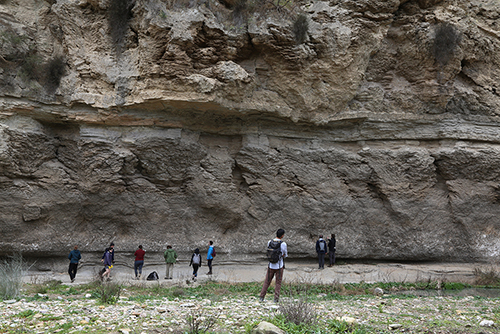 The famous 'gypsum cones' in the Rio Agua, near the Sorbas Caves. As I tell the students, this is a one-of-a-kind outcrop that can only be seen in person to be appreciated.
The famous 'gypsum cones' in the Rio Agua, near the Sorbas Caves. As I tell the students, this is a one-of-a-kind outcrop that can only be seen in person to be appreciated.
Day 4. We continued into the Sorbas basin, where we first visited the classic Abad carbonate-marl and gypsum-marl cycles and contemplated how orbitally forcing generated these cycles. It was a generally cloudy and periodically rainy day, and it required some creative driving to wrestle our vans back to the main road following our first stop. We then continued out to the coast to chase down the strike-slip Carboneras Fault in outcrop, then the linked Palomeras Fault from a panoramic view in Mojácar. After a stroll about the ancient walled, moorish city, we returned to our hotel in Cariatiz and discovered wonderful tapas at the bar across the street.
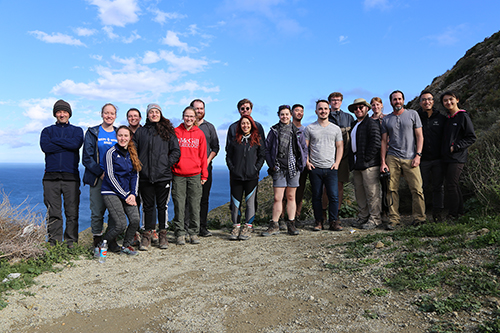 A gratuitous group photo with the Mediterranean in the background. But don't let the blue sky or Pascale's shorts fool you—it was chilly and blustery!
A gratuitous group photo with the Mediterranean in the background. But don't let the blue sky or Pascale's shorts fool you—it was chilly and blustery!
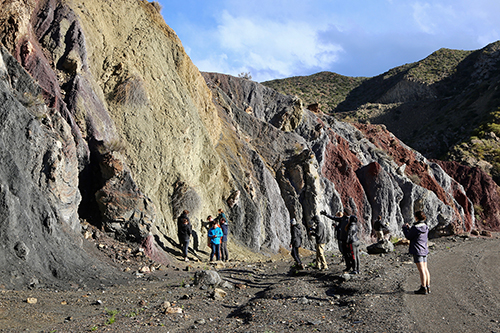 The colourful Carboneras Fault Zone elicited significant and impasssioned discussion on the outcrop.
The colourful Carboneras Fault Zone elicited significant and impasssioned discussion on the outcrop.
Day 5. We continued in the Sorbas basin, spending the morning at the Cantona Hill overlook, where the students can take in the whole of the basin and the basement uplifts that bound it. We never take the same track when we go to that site, and this time we took a slightly more challenging route that involved a long, uphill slog. But it was worth it for the views and a bit of exercise. After lunch, we spent the afternoon in Sorbas, admiring shoreface parasequences which include beautiful barrier island and lagoon deposits and sandy stromatolites. Most of the group finished off the day with a tour of the Sorbas caves, carved into the gypsum deposits.
 The view behind (to the northeast of) the village of Sorbas. The cliffs below are made up of foreshore sandstone, and the recessive beds above are lagoonal mudstone. The upward continuity of sandstone on the right side of the photo (basinward) reveals the location of the ancient barrier island, and the tongue of sand in the middle of the photo shows spill-over of those sands in a flood-tidal delta.
The view behind (to the northeast of) the village of Sorbas. The cliffs below are made up of foreshore sandstone, and the recessive beds above are lagoonal mudstone. The upward continuity of sandstone on the right side of the photo (basinward) reveals the location of the ancient barrier island, and the tongue of sand in the middle of the photo shows spill-over of those sands in a flood-tidal delta.
Day 6. Driving day... we relocated from the Neogene basins in Almería Province to the Cretaceous Maestrat basin in Teruel Province. The drive took most of the day, but delivered us to the Albergue de Aliaga before nightfall. This is a wondeful, mountainous area in the Iberian Ranges that is off the radar for most tourists. It is part of an Alpine fold and thrust belt that inverted Cretaceous strata deposited during and following rifting coeval with opening of the Atlantic Ocean. The last time I took students to Aliaga (in 2016), it snowed 30 cm on us, prevented any useful fieldwork. This time, even though not balmy, the weather was acceptable and we enjoyed two days of limited precipitation and lots of time outdoors.
Day 7. Section day! We began this day my favourite way to spend a day in a new area with unfamiliear stratigraphy. We took a long walk through the Cretaceous stratigraphy west of Miravete de la Sierra, finishing up on a rudist carbonate platform with spectacular outcrops revealing its sequence stratigraphic evolution. After the walk, we visited nearby dinosaur tracks on the other side of Miravete, where Robert Bourque, our own dinosaur expert, dispelled skeptism about the tracks' origins and gave the class a lesson on the differences between ornithscan, therapod, and sauropod tracks.
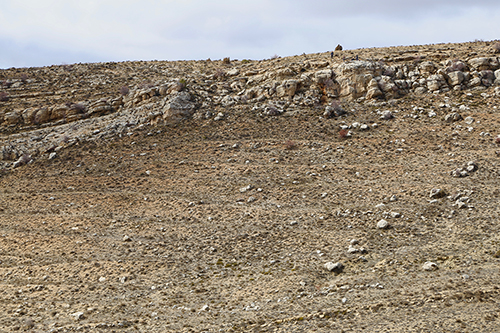 Highstand clinoforms pinching out basinward (to the left in the photo) of the Benassal Formation on the western limb of the Miravete Anticline.
Highstand clinoforms pinching out basinward (to the left in the photo) of the Benassal Formation on the western limb of the Miravete Anticline.
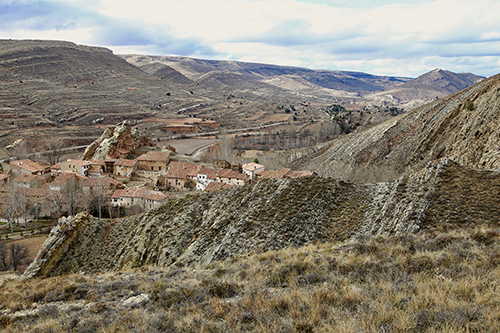 The view of Miravete de la Sierra and the Miravete Anticline from the dinosaur track site. It was a cool, grey day, but this village was nevertheless lovely. Must return during the summer some time.
The view of Miravete de la Sierra and the Miravete Anticline from the dinosaur track site. It was a cool, grey day, but this village was nevertheless lovely. Must return during the summer some time.
Day 8. We spent another day in the Aliaga area, first visiting the more developed dinosaur track site at Las Ceradillas, then hunkering down to log some section and trace sequence stratigraphic surfaces near Camarillas. We wrapped up the day surveying the geology, landscape, and architecture around Aliaga, including a crumbling 12th century castle built into the vertically dipping strata.
 Al enjoys the scenery and a bit of much appreciated sunshine near the broken nose of the Miravete Anticline, outside Aliaga.
Al enjoys the scenery and a bit of much appreciated sunshine near the broken nose of the Miravete Anticline, outside Aliaga.
Day 9. We left Aliaga for the Pyrenees in the morning, driving across the Ebro Foreland basin, replete with gyspum deposits, and skirting Zaragoza. As we climbed out of the Ebro River valley into the edge of the Pyrenean fold and thrust belt, we crossed through progressively older and more deformed rocks—just as tectonics class tells us we should. On a whim, we pulled into the town of Olvena, which advertises a 'mirador' (lookout). It was a harrowing drive to this town perched on a peak of Paleogene carbonate conglomerates, but it would have been much worse had we tried to drive through the town towards the lookout. Fortunately, we made the right decision and reversed to the parking lot on the outskirts of town and walked up the steep, narrow, and winding streets and trails to the lookout. It was an excellent lunch spot, affording views across the Pyrenean foothills and down onto steeply dipping, folded and faulted rocks.
After lunch, we continued to Campo, where we had hoped to spend an entire afternoon investigating a platformal section spanning the K-Pg and PETM boundaries. Between some confusion about how to get to the outcrops and downpours, it turned into a brief stop on the outcrop, where we did just manage to find the PETM and identify some of the abundant Alveolina forams. We then drove through intense rains to the town of Ainsa, which was only chosen on this trip as a stopover for the night. However, next time, we will spend some more time there to check out the delta front and slope deposits, confined laterally by the Boltaña and Mediano anticlines in a piggyback basin.
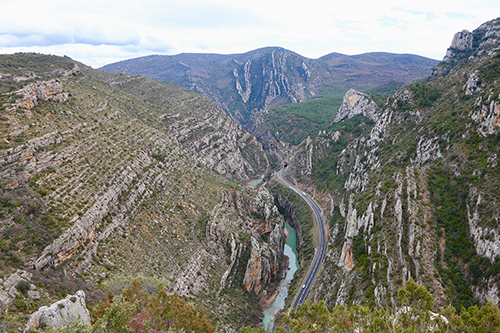 A view from the mirador at Olvena. A fine lunch stop it was.
A view from the mirador at Olvena. A fine lunch stop it was.
Day 10. This was our last day, but it was a very full day. First, we drove west through the axis of the Jaca basin (and along the Camino de Santiago) to Pamplona, then we made our way to Lizarraga pass, where the PETM is exposed on the edge of a carbonate platform in the high, sheep-grazing terrain of Basque Country. It was foggy and intermittenly rainy with a biting wind—not inspring weather. But it was great to get out of the vans and hike around, and in the end we not only walked through a prograding carbonate reef system, but also picked out the impressive 'Andia incision' (paleovalley carved into the platform) and tracked down the PETM. Pascale, Wilder, and Will would return the next day to measure and sample the section properly.
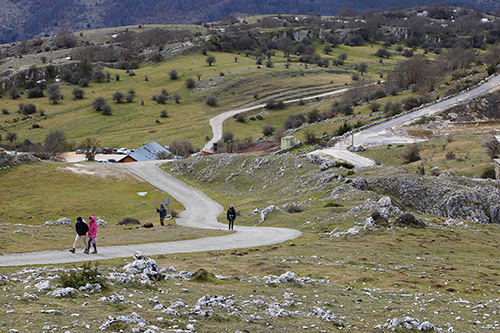 A high plateau in Basque country, where Paleocene to Eocene carbonate platform rocks are well exposed in a bucolic setting.
A high plateau in Basque country, where Paleocene to Eocene carbonate platform rocks are well exposed in a bucolic setting.
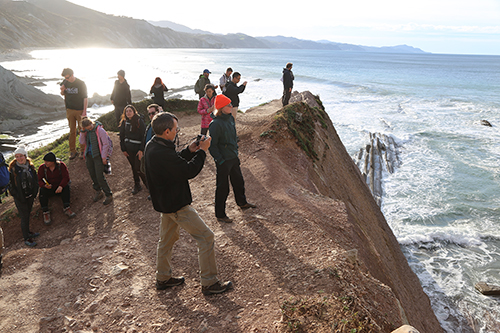 The group takes in the K-Pg section from above. Because it was high tide, we coudldn't descend to the exposures of the boundary, but we were hardly in a position to complain.
The group takes in the K-Pg section from above. Because it was high tide, we coudldn't descend to the exposures of the boundary, but we were hardly in a position to complain.
From Lizarraga, we dropped down to the Atlantic coast to see the famous K-Pg and PETM boundary sections in the deep-water part of the basin. I had previously visited the K-Pg section on a field trip while a graduate student (back in 1999), and although impressed, had not fully appreciated how wonderful this site is (nor had we gone to visit the PETM section). This was the last stop of the field trip, and it was some kind of idyllic, not only because of the stunning geology and views, but also because the sun emerged and bathed us in the warmest temperatures of the trip. The contrasting and steeply dipping flysch made for superb photography, and the temptation of the beach was too much for the students to pass up. We left begrudingly, but appreciated our last night in Spain, comfortably lodged in the beach town of Zarautz.
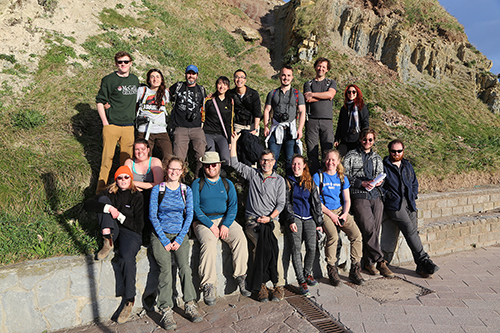 The group straddles the PETM boundary section. Al helpfully points out where Will is standing.
The group straddles the PETM boundary section. Al helpfully points out where Will is standing.
 Hard to resist the temptations of cooling their dogs in the Atlantic ocean on this brilliant spring evening in Basque country.
Hard to resist the temptations of cooling their dogs in the Atlantic ocean on this brilliant spring evening in Basque country.
 The juxtaposition of steeply dipping flysch, sand, ocean, and sky made for easy photography.
The juxtaposition of steeply dipping flysch, sand, ocean, and sky made for easy photography.
The End. And then the trip was over. Most of us awoke obscenely early because many of the students had 6:30 flights out of Bilbao, an hour's drive away. Al and I also had to clean the vans and turn them in, which is always the most stressful part of a fieldtrip, after the abuses geologists heap upon their vehicles. By a miracle, we escaped any costs for damages or cleaning and happily exchanged the car keys for boarding passes back to Montreal.